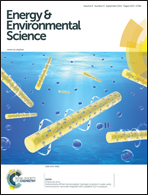Self-powered deep brain stimulation via a flexible PIMNT energy harvester†
Abstract
Deep brain stimulation (DBS) is widely used for neural prosthetics and brain–computer interfacing. Thus far in vivo implantation of a battery has been a prerequisite to supply the necessary power. Although flexible energy harvesters have recently emerged as alternatives to batteries, they generate insufficient energy for operating brain stimulation. Herein, we report a high performance flexible piezoelectric energy harvester by enabling self-powered DBS in mice. This device adopts an indium modified crystalline Pb(In1/2Nb1/2)O3–Pb(Mg1/3Nb2/3)O3–PbTiO3 (PIMNT) thin film on a plastic substrate to transform tiny mechanical motions to electricity. With slight bending, it generates an extremely high current reaching 0.57 mA, which satisfies the high threshold current for real-time DBS of the motor cortex and thereby could efficiently induce forearm movements in mice. The PIMNT based flexible energy harvester could open a new avenue for future in vivo healthcare technology using self-powered biomedical devices.


 Please wait while we load your content...
Please wait while we load your content...